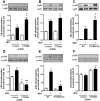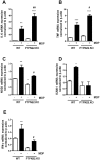Protein tyrosine phosphatase non-receptor type 22 modulates NOD2-induced cytokine release and autophagy
- PMID: 23991106
- PMCID: PMC3753240
- DOI: 10.1371/journal.pone.0072384
Protein tyrosine phosphatase non-receptor type 22 modulates NOD2-induced cytokine release and autophagy
Abstract
Background: Variations within the gene locus encoding protein tyrosine phosphatase non-receptor type 22 (PTPN22) are associated with the risk to develop inflammatory bowel disease (IBD). PTPN22 is involved in the regulation of T- and B-cell receptor signaling, but although it is highly expressed in innate immune cells, its function in other signaling pathways is less clear. Here, we study whether loss of PTPN22 controls muramyl-dipeptide (MDP)-induced signaling and effects in immune cells.
Material & methods: Stable knockdown of PTPN22 was induced in THP-1 cells by shRNA transduction prior to stimulation with the NOD2 ligand MDP. Cells were analyzed for signaling protein activation and mRNA expression by Western blot and quantitative PCR; cytokine secretion was assessed by ELISA, autophagosome induction by Western blot and immunofluorescence staining. Bone marrow derived dendritic cells (BMDC) were obtained from PTPN22 knockout mice or wild-type animals.
Results: MDP-treatment induced PTPN22 expression and activity in human and mouse cells. Knockdown of PTPN22 enhanced MDP-induced activation of mitogen-activated protein kinase (MAPK)-isoforms p38 and c-Jun N-terminal kinase as well as canonical NF-κB signaling molecules in THP-1 cells and BMDC derived from PTPN22 knockout mice. Loss of PTPN22 enhanced mRNA levels and secretion of interleukin (IL)-6, IL-8 and TNF in THP-1 cells and PTPN22 knockout BMDC. Additionally, loss of PTPN22 resulted in increased, MDP-mediated autophagy in human and mouse cells.
Conclusions: Our data demonstrate that PTPN22 controls NOD2 signaling, and loss of PTPN22 renders monocytes more reactive towards bacterial products, what might explain the association of PTPN22 variants with IBD pathogenesis.
Conflict of interest statement
Figures








Similar articles
-
Crohn's disease-associated polymorphism within the PTPN2 gene affects muramyl-dipeptide-induced cytokine secretion and autophagy.Inflamm Bowel Dis. 2012 May;18(5):900-12. doi: 10.1002/ibd.21913. Epub 2011 Oct 21. Inflamm Bowel Dis. 2012. PMID: 22021207
-
TNF-α-Induced NOD2 and RIP2 Contribute to the Up-Regulation of Cytokines Induced by MDP in Monocytic THP-1 Cells.J Cell Biochem. 2018 Jul;119(7):5072-5081. doi: 10.1002/jcb.26227. Epub 2018 Mar 25. J Cell Biochem. 2018. PMID: 28639322
-
Distinct roles for Nod2 protein and autocrine interleukin-1beta in muramyl dipeptide-induced mitogen-activated protein kinase activation and cytokine secretion in human macrophages.J Biol Chem. 2011 Jul 29;286(30):26440-9. doi: 10.1074/jbc.M111.237495. Epub 2011 Jun 9. J Biol Chem. 2011. PMID: 21659536 Free PMC article.
-
Loss of protein tyrosine phosphatase nonreceptor type 22 regulates interferon-γ-induced signaling in human monocytes.Gastroenterology. 2013 May;144(5):978-988.e10. doi: 10.1053/j.gastro.2013.01.048. Epub 2013 Feb 1. Gastroenterology. 2013. PMID: 23380085
-
Tyrosine phosphatase PTPN22: multifunctional regulator of immune signaling, development, and disease.Annu Rev Immunol. 2014;32:83-119. doi: 10.1146/annurev-immunol-032713-120249. Epub 2013 Dec 18. Annu Rev Immunol. 2014. PMID: 24364806 Free PMC article. Review.
Cited by
-
The Innate Immune System: A Trigger for Many Chronic Inflammatory Intestinal Diseases.Inflamm Intest Dis. 2016 Jul;1(2):70-77. doi: 10.1159/000445261. Epub 2016 Apr 28. Inflamm Intest Dis. 2016. PMID: 29922660 Free PMC article. Review.
-
The role for protein tyrosine phosphatase non-receptor type 22 in regulating intestinal homeostasis.United European Gastroenterol J. 2016 Jun;4(3):325-32. doi: 10.1177/2050640615600115. Epub 2015 Aug 6. United European Gastroenterol J. 2016. PMID: 27403297 Free PMC article. Review.
-
PTPN22 regulates NLRP3-mediated IL1B secretion in an autophagy-dependent manner.Autophagy. 2017 Sep 2;13(9):1590-1601. doi: 10.1080/15548627.2017.1341453. Epub 2017 Aug 8. Autophagy. 2017. PMID: 28786745 Free PMC article.
-
Targeted inhibition of PTPN22 is a novel approach to alleviate osteogenic responses in aortic valve interstitial cells and aortic valve lesions in mice.BMC Med. 2023 Jul 13;21(1):252. doi: 10.1186/s12916-023-02888-6. BMC Med. 2023. PMID: 37443055 Free PMC article.
-
Genotype-Phenotype Associations of the CD-Associated Single Nucleotide Polymorphism within the Gene Locus Encoding Protein Tyrosine Phosphatase Non-Receptor Type 22 in Patients of the Swiss IBD Cohort.PLoS One. 2016 Jul 28;11(7):e0160215. doi: 10.1371/journal.pone.0160215. eCollection 2016. PLoS One. 2016. PMID: 27467733 Free PMC article.
References
-
- Chen G, Shaw MH, Kim YG, Nunez G (2009) NOD-like receptors: role in innate immunity and inflammatory disease. Annu Rev Pathol 4: 365–398. - PubMed
-
- Girardin SE, Boneca IG, Viala J, Chamaillard M, Labigne A, et al. (2003) Nod2 is a general sensor of peptidoglycan through muramyl dipeptide (MDP) detection. J Biol Chem 278: 8869–8872. - PubMed
-
- Ogura Y, Bonen DK, Inohara N, Nicolae DL, Chen FF, et al. (2001) A frameshift mutation in NOD2 associated with susceptibility to Crohn's disease. Nature 411: 603–606. - PubMed
-
- Hugot JP, Chamaillard M, Zouali H, Lesage S, Cezard JP, et al. (2001) Association of NOD2 leucine-rich repeat variants with susceptibility to Crohn's disease. Nature 411: 599–603. - PubMed
Publication types
MeSH terms
Substances
LinkOut - more resources
Full Text Sources
Other Literature Sources
Molecular Biology Databases
Research Materials
Miscellaneous

